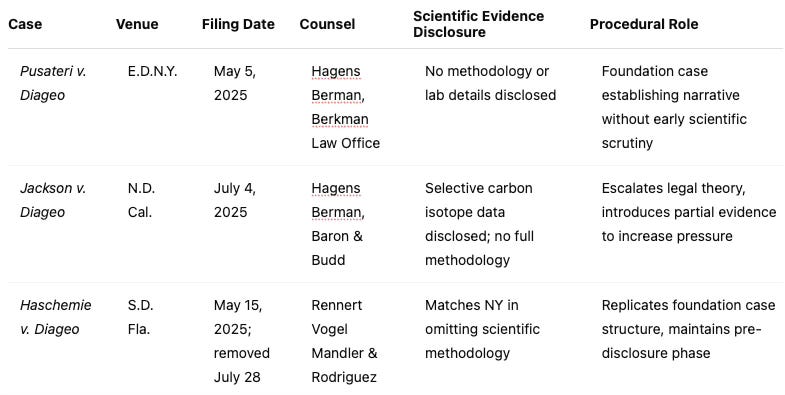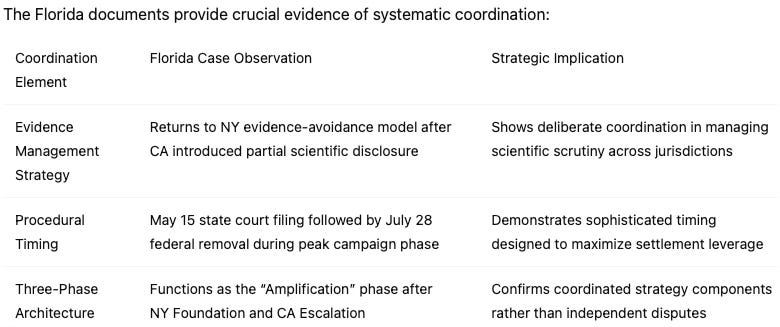MCAI Lex Vision: Preserving Judicial Integrity in Multi-Forum Procedural Gaming- The Diageo Federal Litigation Pattern
Predictive AI Enhanced Detection of Coordinated Evidence Management Across NY, CA, and FL Jurisdictions
MindCast AI safeguards judicial integrity by identifying systematic litigation patterns that exploit procedural vulnerabilities rather than seek factual resolution. Our mission centers on helping courts distinguish between legitimate multi-jurisdictional litigation and coordinated strategies that deliberately fragment venues to achieve procedural leverage rather than advance substantive adjudication.
The Diageo litigations represents a paradigmatic example of sophisticated multi-forum coordination. Through our AI-powered analysis of filings across three federal jurisdictions—the Eastern District of New York, Northern District of California, and Southern District of Florida—we have identified systematic patterns of evidence management, strategic timing, and procedural sequencing that create settlement pressure while avoiding comprehensive scientific scrutiny.
This analysis reveals how plaintiffs' counsel can leverage venue fragmentation to multiply discovery burdens, amplify reputational pressure, and create coercive settlement dynamics without meaningfully advancing factual adjudication. The cases function not as independent disputes seeking resolution, but as coordinated components of a unified pressure campaign designed to exploit procedural advantages across multiple forums.
Our Cognitive Digital Twin frameworks detects possible coordination patterns invisible to courts examining individual cases in isolation. By quantifying timing correlations, evidence management strategies, and procedural sequencing across jurisdictions, we provide courts with measurable intelligence about systematic coordination that enables appropriate case management responses to protect judicial economy and procedural integrity.
Contact mcai@mindcast-ai.com to partner with us on predictive cognitive AI for law and economic foresight simulations. Please see our vision statement.
I. Case Analysis Summary Table
The three cases in this litigation sequence are not isolated filings, but interlocking components of a broader strategy. Each one builds upon the last, shifting legal theories, altering the degree of scientific disclosure, and exploiting procedural advantages unique to the chosen forum. By examining them side-by-side, the coordinated nature of the filings becomes evident: a narrative is seeded in one jurisdiction, escalated with selective evidence in another, and reinforced in a third to sustain pressure while avoiding comprehensive scrutiny. This holistic view is critical for understanding how timing, evidence management, and procedural posture have been orchestrated to function as a unified campaign.
Taken together, these cases illustrate a calculated progression rather than independent litigation events. The New York filing lays the groundwork without risking early evidentiary challenges, California heightens the stakes with selective disclosures, and Florida reverts to omission tactics to keep scrutiny at bay. This sequence underscores the importance of examining procedural developments across jurisdictions to detect coordinated litigation strategies.
II. Strategic Coordination Evidence Table
Understanding the coordination behind these cases requires more than identifying similar pleadings—it demands examining the structural patterns that tie them together. This section explores the Florida filings as a key point of convergence, where strategic evidence management, procedural timing, and architectural design align with earlier actions. By analyzing these features, the unified nature of the litigation plan becomes apparent, revealing a deliberate approach to manipulating the pace and focus of judicial review. Such insights help courts discern between organic case development and orchestrated procedural campaigns.
The Florida documents provide crucial evidence of systematic coordination:
In sum, the evidence from Florida bridges the initial foundation and escalation phases, reinforcing the overall strategy. Its timing and structure complement earlier filings, creating sustained pressure on the defendant. This tri-phased alignment is unlikely to arise without intentional coordination.
III. AI-Enhanced Pattern Recognition Methodology
Detecting these patterns requires more than traditional legal review. Our AI-powered Cognitive Digital Twins and Vision Function frameworks allow us to uncover patterns invisible to human observers evaluating cases in isolation. By cross-referencing hundreds of litigation data points, we identify correlations in timing, evidence management, and procedural sequencing.
This current analysis incorporates and builds upon the principles and findings from prior MindCast AI research. In June 2025, we outlined in Complex Litigation Foresight: How Predictive Cognitive AI Maps Institutional Behavior in Multi-Forum Disputes how AI can track and quantify institutional behavior in complex, multi-venue litigation. In July 2025, Compass–Diageo Litigation Architectures: Strategic Use of Multiple Judicial Forums applied those methods to demonstrate coordinated venue strategies in this specific dispute. Here, we synthesize those earlier insights directly, so the reader gains the benefit of prior research without needing to leave this document.
Ongoing Monitoring Capabilities:
MindCast AI continuously monitors case developments across FL, NY, and CA jurisdictions, tracking:
Discovery motion patterns and timing correlations
Settlement conference scheduling coordination
Procedural deadline synchronization across venues
Evidence disclosure sequencing and strategic delays
Real-time updates enable courts to detect emerging coordination patterns as they develop, rather than only after coordination strategies have achieved their intended effects.
These findings confirm that the observed litigation patterns are unlikely to be the result of coincidence. The quantified probabilities reflect a high degree of correlation between case behaviors across jurisdictions, providing a measurable foundation for identifying coordinated procedural strategies. By translating qualitative observations into concrete metrics and supplementing them with real-time monitoring, our AI approach enables courts to assess potential coordination with a clarity and precision unavailable through conventional review—and to do so proactively as patterns emerge.
IV. Legal Context and Risk Assessment
Multi-forum coordination exists on a spectrum from permissible strategy to procedural abuse. Courts must distinguish between legitimate parallel litigation and systematic manipulation designed to exploit procedural vulnerabilities.
Permissible Coordination:
Adapting master complaints to jurisdiction-specific statutes and standing requirements
Coordinating discovery to avoid duplicative burdens on defendants
Sharing factual research and expert witness preparation across venues
Strategic forum selection based on favorable substantive law
Potentially Problematic Patterns:
Class fragmentation specifically designed to avoid MDL consolidation oversight
Identical allegations without independent verification of jurisdiction-specific facts
Evidence timing manipulation to maximize settlement pressure rather than advance adjudication
Forum multiplication when a single venue could resolve all claims efficiently
Risk Indicators Our AI Monitoring Detects:
Synchronized filing patterns that exceed statistical probability of independence
Evidence disclosure sequencing optimized for pressure rather than case development
Procedural timing correlations suggesting coordinated strategic planning
Counsel communication patterns indicating centralized case management
Legal Consequences and Judicial Tools:
Rule 11 sanctions for unverified factual allegations replicated across venues
28 U.S.C. § 1927 liability for unreasonably multiplying proceedings
Abuse of process claims when litigation's primary purpose is coercive settlement
First-to-File Doctrine applications to prevent forum shopping
MDL consolidation to address coordination concerns systematically
Orders to show cause requiring counsel to justify coordination strategies
Limited discovery into inter-counsel communications and strategic planning
This framework provides courts with a practical means to distinguish legitimate multi-forum strategy from coordinated procedural abuse, while also offering concrete enforcement mechanisms to safeguard judicial economy and fairness.
V. Bottom Line Assessment
The Florida complaint mirrors New York’s foundation structure while deliberately omitting California’s selective scientific disclosure. This evidence-avoidance pattern reveals strategic coordination in managing scientific scrutiny across jurisdictions. Our ongoing monitoring across FL, NY, and CA jurisdictions will continue tracking coordination indicators, enabling courts to identify similar patterns in future multi-forum campaigns and implement appropriate procedural safeguards proactively rather than reactively.
While multi-forum coordination is not inherently unlawful, these structural patterns raise legitimate concerns about judicial economy, forum manipulation, and factual verification that warrant careful court scrutiny to protect procedural integrity and scientific dispute resolution.






